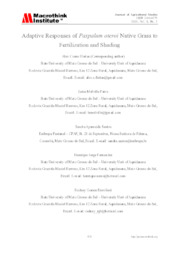Adaptive responses of Paspalum oteroi native grass to fertilization and shading.
Adaptive responses of Paspalum oteroi native grass to fertilization and shading.
Author(s): FLEITAS, A. C. F.; PAIVA, L. M.; SANTOS, S. A.; FERNANDES, H. J.; BREVILIERI, R. G.; SANTOS, P. G. dos
Summary: Abstract: The aim of this study was to evaluate the Paspalum oteroinative grass and its adaptive responses to shadingand foliarfertilization in two pasture systems in the Cerrado-Pantanal transition region. A completely randomized block design with factorial arrangement was adopted to this study: three types of fertilizers [no fertilization ?control (C); Foliar fertilizer for pasture (FF) and Soil fertilizer + Foliar fertilizer (SF)]xtwo pasture systems (WS -with shading, wooded P. oteroipasture; NS -no shading, exclusive P. oteroipasture)with four repetitions. P. oteroiseedlings were transplanted in November 2015. Data collection was from May 2016 to September 2016, during dry season. There were differences (p<0.05) in the sward height variables (H), dry matter (DM), crude protein (CP) content, dry matter production (DMP) and shoot: root ratio (S:R).In the WS system increasedof 8,61% of the CP content and fertilizer SF increasedof 8.81% of the CP content. However, in the WS system was observed reduced DM, DMP and S:R and in the FF and SF fertilizers increased leaf area index (LAI), inthe latter months of the application. Probably, P. oteroigrass developed adaptation strategies to deal with the environmental conditions to which it was submitted during this study, such as variations in its morphophysiological traits: low shoot / root ratio, height, chemical composition, leaf area index e light interception. In conclusion, P. oteroishowed adaptation to wooded pasture systems, during dry period, however, the use of fertilization depends on economic viability studies.
Publication year: 2020
Types of publication: Journal article
Unit: Embrapa Pantanal
Keywords: Forage quality, Gramínea Forrageira, Qualidade
Observation
Some of Embrapa's publications are published as ePub files. To read them, use or download one of the following free software options to your computer or mobile device. Android: Google Play Books; IOS: iBooks; Windows and Linux: Calibre.
Access other publications
Access the Agricultural Research Database (BDPA) to consult Embrapa's full library collection and records.
Visit Embrapa Bookstore to purchase books and other publications sold by Embrapa.

